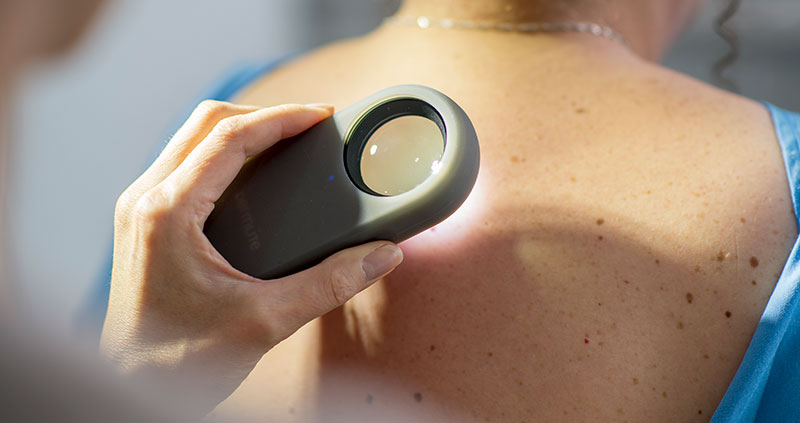Why trust our skin specialists to perform mole checks for you?

A mole check is a visual inspection of your skin by a medical professional. Dermatologists are the most highly trained doctors in skin conditions and spend all our time looking at the skin to make diagnoses. As such we have the most experience and expertise to detect atypical skin lesions early.
Why are regular mole checks important?
Regular skin checks either done by yourself, your partner or a doctor are very important as new moles and changes to existing moles can be a sign of melanoma.
Melanoma is a type of skin cancer, which usually occurs on the parts of the body that have been overexposed to the sun. Rare melanomas can occur in parts of the skin or body that have never been exposed to the sun. Melanoma is the most lethal form of skin cancer. Melanoma may spread to lymph nodes and internal organs so early detection and treatment is essential.
Melanoma is the third most common form of cancer for both men and women. It is the most common cause of cancer for Australians aged 15 to 44 years.
Caught early, melanoma is highly treatable. Early detection is the key – the earlier a melanoma is found and removed the better your prognosis.
What causes moles to appear?
The medical name for moles are naevi.
They are common with almost every adult having a few of them. Adults who have light skin often have more moles.
Moles occur when the pigment cells in the skin (called melanocytes) grow in a cluster instead of being spread throughout the skin.
Most moles appear on the skin during childhood and adolescence. Moles will grow as the child (or teenager) grows. Some moles will darken, and others will lighten. Moles may darken after exposure to the sun, during the teenage years, and during pregnancy. These changes are expected and seldom a sign of melanoma, the most-serious skin cancer.
What types of moles should I be concerned about?
Change is the key.
Melanomas are often a new skin lesions that you have not noticed before that goes on to change or less commonly a mole that you may have had for a long time that undergoes change.
Early melanomas are often flat changing lesions. DO NOT wait until they become raised, sore or bleed. A changing mole is a suspicious mole. Get it checked NOW.
Taking a photo of a mole you are unsure of can be useful. This will allow you to more accurately monitor it for change over time.
What should I look for?
A = Asymmetry
- One half is unlike the other half
- Benign (non-cancerous and non-malignant) are usually round in shape (symmetrical)
- Melanoma lesions are typically irregular in shape (asymmetrical)
B = Border
- An irregular, scalloped or poorly defined border
- Benign moles have smooth even borders
- Melanoma lesions often have uneven borders (ragged or notched edges)
C = Colour
- Is varied from one area to another; has shades of tan, brown or black, or is sometimes white, red, or blue
- Benign moles are usually a single shade of brown
- Melanoma lesions often contain multiple colours (brown, black, pink, red or purple)
D = Diameter
- Melanomas are usually greater than 6mm (the size of a pencil eraser) when diagnosed, but they can be smaller
E = Evolving
- A mole or skin lesion that looks different from the rest or is changing in size, shape or colour
- Benign moles usually do not change over time
- Melanomas often grow in shape or change in height
How frequently should I have my moles checked?
It is very important that you “own†your own skin and know which moles are already present. That way you are far more likely to spot a new or changing mole at the earliest stage. You need to check your own skin at least every 3 months – or at the change of every season.
The risk of melanoma is highest for those people who have:
- Fair skin, freckles, red hair, light coloured eyes and a tendency to burn rather than tan
- A family history of melanoma
- An increased number of unusual moles (dysplastic naevi)
- Depressed immune system (including transplant patients on immune-suppression treatments)
- Previous melanoma or non-melanoma skin cancers
For most people who are not high risk checking your own skin or getting a partner to check areas you can’t see is sufficient. If there is anything you are concerned about your GP is the best first point of contact.
Dermatologists will often see high risk people every 6 to 12 months